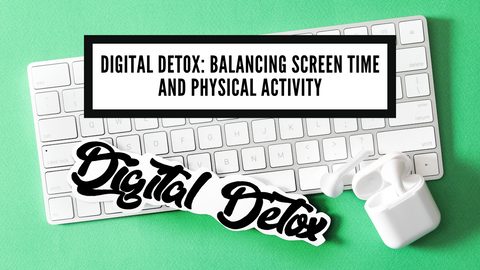Digital Detox: Balancing Screen Time and Physical Activity

In the digital age, screens have become an integral part of our lives, connecting us to a world of information and entertainment. However, this constant connectivity has led to concerns about the impact of excessive screen time on our physical and mental well-being. The concept of a "digital detox" has gained traction as a way to strike a balance between screen time and physical activity. As times goes on, the importance of managing screen time grows for achieving a healthier equilibrium.
The Screen-Time Dilemma
From smartphones to tablets, laptops to TVs, screens have woven themselves into the fabric of our daily routines. While these devices offer convenience and connectivity, the excessive use of screens has been linked to a range of health issues, including sedentary behavior, eye strain, sleep disruption, and reduced physical activity. The challenge lies in finding ways to harness the benefits of technology while minimizing its potential drawbacks.
The Power of a Digital Detox
A digital detox refers to intentionally disconnecting from electronic devices for a designated period to reset and rejuvenate. This practice allows individuals to rediscover real-world experiences, including physical activity, social interactions, and mindfulness.
The benefits of a digital detox include:
- Increased Physical Activity: Cutting back on screen time opens up opportunities for movement and exercise. Whether it's a brisk walk, a yoga session, or a workout at the gym, engaging in physical activity becomes more appealing when screens are put aside.
- Reduced Eye Strain: Extended screen time can strain our eyes and lead to discomfort. Taking a break from screens allows our eyes to relax and recover, contributing to better visual health.
- Improved Sleep Quality: The blue light emitted by screens can interfere with the production of melatonin, a hormone that regulates sleep. A digital detox before bedtime can lead to better sleep quality and overall well-being.
- Enhanced Social Interactions: Disconnecting from screens encourages face-to-face interactions, strengthening relationships and fostering a sense of community.
- Set Screen-Time Limits: Determine specific time slots for using screens and stick to them. Use apps or device settings to set time limits for various apps or activities.
- Create Screen-Free Zones: Designate certain areas in your home, such as the dining room or bedroom, as screen-free zones to encourage conversation, relaxation, and quality sleep.
- Prioritize Outdoor Activities: Spend time outdoors engaging in activities like walking, jogging, cycling, or hiking. Nature provides a refreshing backdrop that can help alleviate screen-related stress.
- Use Fitness Apps: Make technology work for you by using fitness apps or wearables to track your physical activity and set goals.
- Practice Mindfulness: Dedicate time each day to mindfulness activities like meditation or deep breathing. These practices help counter the constant distractions of screen-based activities.
- Establish a Bedtime Routine: Create a screen-free bedtime routine to unwind and prepare your mind and body for a restful night's sleep.
